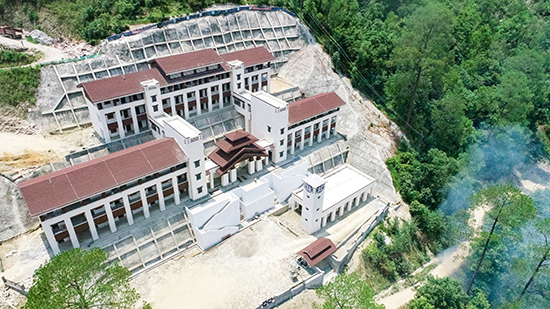
An aerial view of one of the renovated schools in Nepal.
China shares a close and friendly traditional relationship with Nepal, and under the Belt and Road Initiative, the cooperation between the two countries continues to deepen.
The cooperation between POWERHCINA and Nepal can be traced back to the 1980s. In 1985, POWERCHINA undertook the construction of the intake tunnel for the Marsyangdi Hydropower Station in Nepal, marking the beginning of a mutually-beneficial relationship between the two sides.
The construction faced complex geological conditions, fragmented rock formations, and frequent rockfalls. In a 13-month period from Aug 18, 1986, when the excavation of the intake tunnel officially began, to Sept 27, 1987, when it reached a length of 3,479 meters, there were 177 collapses, containing a total volume of over 1,500 cubic meters of rock. On average, there was a collapse of 9 cubic meters for every 20 meters of excavation.
However, POWERCHINA's construction team overcame these challenges by applying Chinese experience and new technologies, ensuring both construction quality and efficiency. The team completed the project in July, 1989.
In 2010, POWERCHINA once again went to Nepal to build the Upper Tamakoshi Hydropower Station, the country's largest hydropower station, with a total installed capacity of 456 megawatts.
On March 19, 2022, the completion ceremony for the Upper Tamakoshi Hydropower Station took place, with then-Nepal's Prime Minister Sher Bahadur Deuba attending. He expressed his appreciation for POWERCHINA's contribution, praising the team for alleviating the country's power shortage, further optimizing the energy structure, and promoting rapid local socio-economic development.
In 2015, the Upper Marsyangdi Hydropower Station project was initiated, but it faced a major setback during construction due to the devastating magnitude 8.1 earthquake in Nepal on April 25, 2015. POWERCHINA responded by creating a list of issues and seeking solutions to resume the construction work.
On Jan 1, 2017, the hydropower station set up commercial operations. It has now been operating safely for six years and has generated a cumulative output of over 2.2 billion kilowatt-hours, providing high-quality, clean energy to the capital city of Kathmandu and the country's largest tourism hub, Pokhara.
Similar calamities occurred during the construction of the Melamchi Water Supply Project. However, despite facing major geological disasters such as landslides and the challenges posed by the COVID-19 pandemic, the project was successfully completed, bringing over 5 million local s a safe and clean water source.
In addition, POWERCHINA has been fulfilling its social responsibilities by assisting in the reconstruction of earthquake-affected schools in the northern mountainous regions of Nepal, promoting localized management during the construction of projects, fostering cultural exchanges between the two countries, and providing donations for local drivers in need.
Over the past four decades, POWERCHINA has made significant contributions to improving Nepal's energy structure and economic development. This collaborative journey demonstrates the friendship and cooperation between China and Nepal.